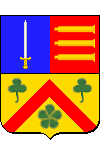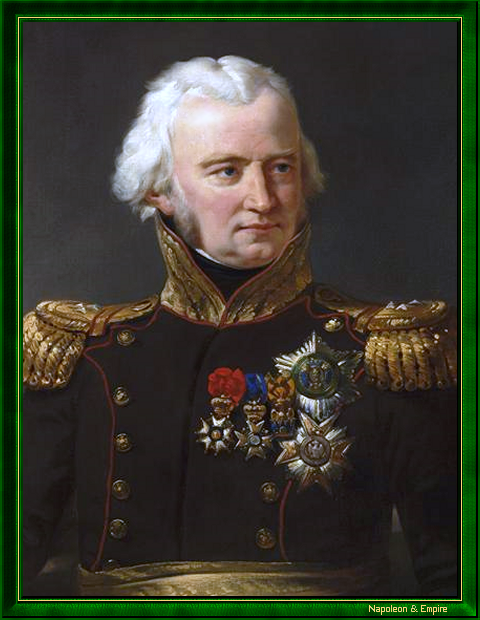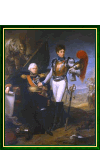Jean Ambroise Baston de Lariboisiere
Count of the Empire, Grand Officer of the Legion of Honor
Pronunciation:

Jean Ambroise Baston de Lariboisière (or La Riboisière, or Lariboisierre, or La Riboissière), son of Ambroise Baston, sieur de Lariboisière, and Anne-Marie Monnière, dame de Neuville, was born in Fougères, Brittany, on August 18, 1759. The village of La Riboisière in the commune of Romagné (6 kilometers from Fougères) was owned by his great-grandmother.
He embarked on a military career at an early age (1780), serving before the Revolution in the same artillery regiment (La Fère) as Napoleon Bonaparte, with whom he made friends in Valence.
Taking advantage of a half-year's leave, he married Marie-Jeanne-Joseph-Victor Le Beschu de la Raslaye on April 17, 1786, a second cousin of Armand Tuffin, Marquis de la Rouêrie (hero of the American Revolution and promoter of the Breton Conjuring).
Captain in 1791, he fought under Adam Philippe de Custine in the Army of the Rhine. After a brief captivity following the surrender of Mainz in 1793, he took part in the campaigns of the Revolution and the Consulate, again as an artilleryman. He was appointed deputy director of artillery at Landau, and then sat on the central artillery committee several times. Successively appointed director general of parks for the Rhine army and director of the Strasbourg Arsenal, he was promoted to the rank of brigadier general in August 1803 and became second-in-command of the artillery at the Bruges camp.
In September 1805, he was appointed artillery commander to Marshal Jean-de-Dieu Soult's corps. At Austerlitz Lariboisière distinguished himself by using his batteries against Russian columns on a frozen pond, causing heavy enemy casualties.
At Jena, on October 14, 1806, he earned the stripes of major general and his appointment as head of the Imperial Guard artillery by breaking several Prussian infantry charges with his artillery alone; this double promotion took place in January 1807.
It was in this position that La Riboisière distinguished himself at Preußisch Eylau on February 8, then in front of Danzig [Gdansk], where he was wounded by a cannonball, and finally at Heilsberg and Friedland, which earned him the honor of directing the construction of the raft on the Niemen on which Napoleon I and Tsar Alexander I met as a prelude to the peace of Tilsit (or Tilsitt).
The following years saw him serve in Spain in 1808, then in 1809 at Aspern-Essling and Wagram, where he became chief artillery officer of the German army.
Made a Grand Officer of the Legion of Honor in June 1807, and a Count of the Empire in March 1808 (final letters patent dated October 26, 1808), Lariboisière became first Inspector General of Artillery in 1811, before taking part in the Russian campaign in 1812, during which his long experience as an artilleryman worked wonders, whether at Smolensk on August 17 or at the Battle of Borodino on September 7. This victory, however, was overshadowed by the death in battle of his youngest son, Ferdinand, a lieutenant of riflemen in the 3rd Company of the 1st Regiment, who succumbed to his wounds on September 12 (he was buried in the city walls of Mojaïsk).
During the fire that ravaged Moscow, it was he who convinced Napoleon to leave the Kremlin, where the flames threatened to explode more than 400 ammunition caissons stored in the courtyard.
At the end of the retreat from Russia, Jean Ambroise Baston de Lariboisière died of exhaustion and grief in Königsberg in East Prussia [now Kaliningrad in Russia] on December 21, 1812.
The general's remains, brought back to France by his son Honoré and Nicolas-Louis Planat de la Faye (both his aides-de-camp), rest at Les Invalides, in the crypt of the governors of Saint-Louis cathedral, and his heart in a private chapel in the grounds of his château de Monthorin , at Louvigne-du-Desert, in Brittany.
"Count Jean Ambroise Baston de Lariboisiere" by Jean-Baptiste Mauzaisse (Corbeil 1784 - Paris 1844).

The name "Lariboissière" is inscribed on the 15th column (east pillar) of the Arc de Triomphe de l'Étoile .
A full-length statue of the general, by Léo Roussel, honors his memory on the north façade of the Louvre, rue de Rivoli .
An equestrian statue by Georges Récipon (1860-1920), which had been inaugurated on June 26, 1893, was removed in June 1942 under the terms of the law of October 11, 1941 relating to the removal of statues and metal monuments with a view to recasting. Prior to removal, by decision of the municipality, a plaster cast was made by the Parisian firm Barsanti. This mold, preserved at the Château de Fougères, was used in 1999 by Mayenne sculptor Louis Derbré to recast the statue identically.
There is also a plaster bust of the general by Pierre Gourdel at the Musée des Beaux-arts in Rennes, and medallion portraits of the general and his son Ferdinand at the Musée de l'Empéri in Salon de Provence.
The archives municipales de Fougères hold 74 letters from Napoleon to the general in a morocco binding.
The Lariboisière hospital in Paris is not named after the general, but after his daughter-in-law, Countess Elisa de Lariboisière.
Awards
Chevalier de la Légion d'Honneur, December 11, 1803,
Commander of the Legion of Honor, June 16, 1804,
Grand officier de la Légion d'Honneur, June 4, 1807,
Chevalier de l'ordre de Saint Henri de Saxe on July 1, 1807,
Commander of the Military Order of Baden on November 30, 1807,
Grand Cross of the Iron Crown on August 14, 1809,
Grand Cordon of the Order of Charles Frederick on October 20, 1809,
Chamberlain's Key, March 10, 1810.
Address
From December 1807, General de La Riboisière owned Château de Monthorin in Louvigné-du-Désert, near his native town of Fougères in Ille-et-Vilaine.
Acknowledgments
We would like to express our gratitude to Major General Christian Baptiste, Director of the Musée de l'Armée, who granted us access to the Governors' vault in the Cathedral Saint-Louis des Invalides, and to Mr. Mickaël Blasselle, who guided us on this visit in December 2011.
We would also like to thank Mr. Milan, son of the current owner of Château de Monthorin, who allowed us to photograph the château and the interior of the chapel housing the heart of General de Lariboisière.
The photo of the full-length statue of General de Lariboisière on rue de Rivoli in Paris was kindly provided by Cyril Maillet, to whom we would like to express our gratitude.
Finally, our thanks go to Mr. Dominique Bouyer, who provided us with useful details of the General's equestrian statue in Fougères, and of various episodes in his biography.
Other portraits

"General Jean-Ambroise Baston de Lariboisiere and his son Ferdinand before the battle of the Moskowa in 1812" by Antoine-Jean Gros (Paris 1771 - Meudon 1835).